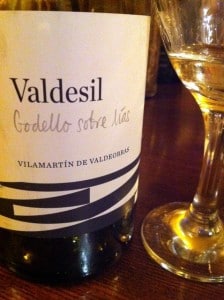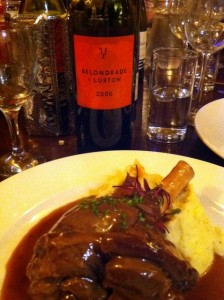October’s BBC (Bring a Bottle Club) was a straightforward delight – a series of pretty much consistently good to very good wines, some teasers when tasted blind, but an excellent general standard. And not too many complete jokers …
Not many thought this sparkling wine was Champagne but plumped for a bottle-fermented sparkling wine perhaps from the New World or from another French region. Medium intensity nose, soft and just a touch on the off-dry side in the mouth, lemon and yellow apple fruit, simple and pleasant with a touch of biscuit on the nose. In fact, it was Champagne, Madame de Maintenon, made in Rheims – and all this for an amazing £7.49 a bottle on special offer from the Co-op. That’s UK wine retailing for you, but on this occasion, we were happy to collude!
 The second wine was a bit of a challenge if a very pleasant one. Clean and rather neutral on the nose, but then quite rich and full-bodied on the palate with relatively fat, peach and apricot fruit and a hint of spice. For the fatness and the spice, I wondered about a semi-aromatic grape-like Traminer, but in fact, this was Godello from Spain: Valdosil, Godello, Vilamartin de Valdeonas, Galicia, 2009.
The second wine was a bit of a challenge if a very pleasant one. Clean and rather neutral on the nose, but then quite rich and full-bodied on the palate with relatively fat, peach and apricot fruit and a hint of spice. For the fatness and the spice, I wondered about a semi-aromatic grape-like Traminer, but in fact, this was Godello from Spain: Valdosil, Godello, Vilamartin de Valdeonas, Galicia, 2009.
This was my own wine and so I was in the impregnable position of knowing what it was. For everyone else it provided the perfect example of once you have persuaded yourself of a grape variety, you shoehorn the wine into that mould – we have all done it. Medium-plus intensity stone fruit and floral notes on the nose, fine mineral finish, spicey and classy. The group view was that it was either Gewurz or Pinot Gris whereas in fact it was Viognier: Domaine Christophe Pichon, Condrieu AC, 2009 and very fine too.
Another very classy wine followed: a fine fresh lemon and sherbet palate, medium-bodied, noticeable mineral edge, not obviously fruity but extremely well made, excellent length. Once we knew what it was one person confessed to having been on the right lines on the grape variety but nobody called classic Sancerre ‘Sauvignon Blanc’. Made in homage to Didier Dagueneau, it is even called Silex backward: X-elis, Gitton Pere & Fils, AC Sancerre 2008. Several people immediately put in orders for this wine, the ultimate accolade.
 The Red Lion’s very good and enormous Lamb Shank was accompanied by a final white and a series of fine reds. The wine had a pronounced aromatic and oaky nose, sweet, ripe, white stone fruit and further wood notes on the palate and a rich finish. Quite a big powerful white which has spent 10 months in French barriques: Belondrade y Lurton, Rueda DO, 2006 from the Verdejo grape variety. Two good examples this evening of the fine white wines now coming out of northern Spain.
The Red Lion’s very good and enormous Lamb Shank was accompanied by a final white and a series of fine reds. The wine had a pronounced aromatic and oaky nose, sweet, ripe, white stone fruit and further wood notes on the palate and a rich finish. Quite a big powerful white which has spent 10 months in French barriques: Belondrade y Lurton, Rueda DO, 2006 from the Verdejo grape variety. Two good examples this evening of the fine white wines now coming out of northern Spain.
Pictures of transparent bottles are best taken with the red liquid inside them …. This turned out to be the first level offering of a fine Sicilian producer – IGT Sicilia Rosso and no list of varieties on the bottle mean that the wine maker can use what is to hand. When the wine is this good we are not going to worry about the percentages but it must be predominantly Nerello Mascalese for its superb, fragrant, sour cherry fruit, zippy acidity and high tannins: delicious, refreshing, grippy: Contadino 3, Cornelissen & Yoko Sano, IGT Sicilia Rosso (in reality 2005).
When is Zinfandel pale and interesting … and not like Zin at all? When it is planted in the south of France and comes out with a surprisingly light colour, markedly oaky notes, high acidity and tannins … Strange but true, and good with the big meat dish. Z de l’Arjolle, Vin de Pays des Cotes de Thongue, 2005. OK – so perhaps there were some jokers at this tasting.
 If Zin is supposed to be rich, fruity and dense, Grenache/Syrah/Mourvedre blends from the south of France are supposed to be full of fruit, perhaps a bit rustic and be drinking within three years, certainly five years, of harvest. But not in the case of the pretty massive, opaque, black fruit and oak-laden wine in front of us, with high acidity and still unforgivingly tough tannins. And this is supposedly 60% Grenache at 12 years old … from a big-name producer. Wine has the capacity to surprise constantly: Terra d’Or, Coteaux d’Aix-en-Provence, M. Chapoutier, 2000. Try again in a decade or two?
If Zin is supposed to be rich, fruity and dense, Grenache/Syrah/Mourvedre blends from the south of France are supposed to be full of fruit, perhaps a bit rustic and be drinking within three years, certainly five years, of harvest. But not in the case of the pretty massive, opaque, black fruit and oak-laden wine in front of us, with high acidity and still unforgivingly tough tannins. And this is supposedly 60% Grenache at 12 years old … from a big-name producer. Wine has the capacity to surprise constantly: Terra d’Or, Coteaux d’Aix-en-Provence, M. Chapoutier, 2000. Try again in a decade or two?
To finish, two contrasting sweet white wines which at least share one grape variety but came from opposite ends of the winemaking world and of the age spectrum. First up, a big waft of honey, marmalade and sweet lusciousness from Australia: Noble One, De Bortoli, 100% Semillon, 2007. Then, a complex combination of old fruit sweetness, botrytised complexity and some deterioration in condition but still good acidity – but then it was nearly three decades old: Ch. Coutet, Barsac AC, 1983, a classic Bordeaux sweet blend of 75% Semillon, 23 Sauvignon Blanc and 2% Muscadelle.
Blind tasting is never easy, but when the wines are this good, it is very rewarding.


Comments are closed.